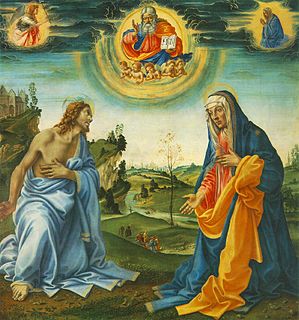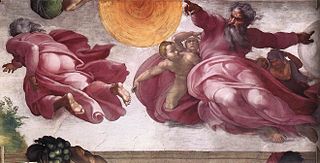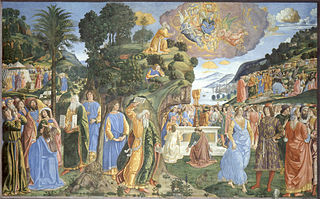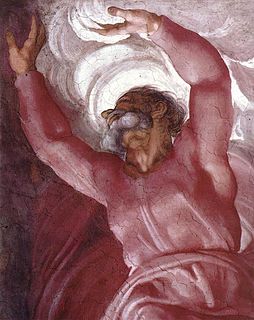 W
WThe Apparition of Christ to the Virgin is a painting by the Italian Renaissance master Filippino Lippi, executed around 1493 and now housed in the Alte Pinakothek of Munich, Germany.
 W
WThe Creation of Adam is a fresco painting by Italian artist Michelangelo, which forms part of the Sistine Chapel's ceiling, painted c. 1508–1512. It illustrates the Biblical creation narrative from the Book of Genesis in which God gives life to Adam, the first man. The fresco is part of a complex iconographic scheme and is chronologically the fourth in the series of panels depicting episodes from Genesis.
 W
WThe Creation of the Sun, Moon and Plants is one of the frescoes from Michelangelo's nine Books of Genesis scenes on the Sistine Chapel ceiling. It is the second scene in the chronological sequence on the ceiling, depicting the third and fourth day of the Creation narrative together in on panel.
 W
WThe Descent from Mount Sinai is a fresco by the Italian Renaissance painter Cosimo Rosselli and his assistants, executed in 1481–1482 and located in the Sistine Chapel, Rome. It depicts the prophet Moses in the process of receiving and introducing the Ten Commandments.
 W
WThe Disputation of the Sacrament, or Disputa, is a painting by the Italian Renaissance artist Raphael. It was painted between 1509 and 1510 as the first part of Raphael's commission to decorate with frescoes the rooms that are now known as the Stanze di Raffaello, in the Apostolic Palace in the Vatican. At the time, this room was known as the Stanza della Segnatura, and was the private papal library where the supreme papal tribunal met.
 W
WThe Four and Twenty Elders Casting their Crowns before the Divine Throne is a pencil drawing and watercolour on paper by the English poet, painter and printmaker William Blake. Created circa 1803–1805, the drawing has been held in London's Tate gallery since 1949. It is likely a visionary and hallucinatory summary of scenes from Chapters 4 and 5 of the Book of Revelation when the throne of God was presented to the prophet Saint John the Divine.
 W
WGod the Father with Two Saints is a 1477–78 fresco by Perugino. It was painted for the church of San Francesco in Deruta and shows the town at its base, along with the inscription "DECRETO PUBBLICO DFCTA / ANNO D[OMI]NI MCCCCLXXV[II/III]". This shows it was an ex voto for the end of the plague in 1476 - the two saints are St Roch (right) and St Romanus (left), both invoked against the plague.
 W
WThe Mural Paintings from the Herrera Chapel is group of mural painting by Annibale Carracci and collaborators, conserved between the National Art Museum of Catalonia and de Museo del Prado.
 W
WThe Separation of Light from Darkness is, from the perspective of the Genesis chronology, the first of nine central panels that run along the center of Michelangelo's Sistine Chapel ceiling and which depict scenes from the Book of Genesis. Michelangelo probably completed this panel in the summer of 1512, the last year of the Sistine ceiling project. It is one of five smaller scenes that alternate with four larger scenes that run along the center of the Sistine ceiling. The Separation of Light from Darkness is based on verses 3–5 from the first chapter of the Book of Genesis:3And God said, "Let there be light," and there was light. 4God saw that the light was good, and He separated the light from the darkness. 5God called the light "day," and the darkness he called "night." And there was evening, and there was morning—the first day.
 W
WThe Trinity and Mystic Pietà is an oil on oak painting produced in 1512 by German artist Hans Baldung.